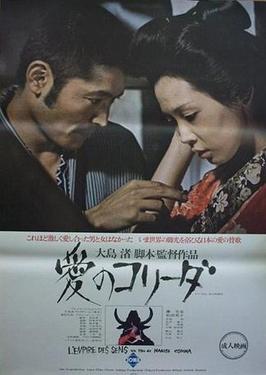 |
| Do-yun Yu and Akiko Koyama in Death by Hanging |
R.: Do-yun Yu
Warden: Kei Sato
Education Officer: Fumio Watanabe
District Attorney: Hosei Kamatsu
Doctor: Rokko Toura
Chaplain: Ishiro Ishida
Chief of Guards: Masao Adachi
Sister: Akiko Koyama
Narrator: Nagisa Oshima
Director: Nagisa Oshima
Screenplay: Michinori Fukao, Mamoru Sasaki, Tsutomu Tamura, Nagisa Oshima
Cinematography: Yasuhiro Yoshioka
Music: Hikaru Hayashi
It's becoming clearer to me that Nagisa Oshima is one of the great artists of the second half of the century whom nobody has heard of. That's an exaggeration, of course: Lots of cinéastes and students of Japanese film obviously know Oshima's work, but ordinary people who pride themselves on their knowledge of Kurosawa or Mizoguchi or Ozu often know little about him. Maybe it's because Oshima doesn't lend himself to easy description: You can't take any one of his films as representative of the style and content of any of the others. There's a vast difference between the harrowing upperclass family drama
The Ceremony (1971) and the poignant account of an abused child's initiation into crime,
Boy (1969), or between the scathing look at rootless Japanese young people in
Cruel Story of Youth (1960) and what is probably Oshima's best-known film in the West, the sexually explicit
In the Realm of the Senses (1976). His willingness to experiment has tagged Oshima as the Japanese Jean-Luc Godard, but he seems to me more the heir to the great modernists of the early-to-mid-20th century: Kafka, Joyce, Faulkner, Brecht, Genet. Certainly
Death by Hanging has been singled out as "Brechtian" for its outrageous transformation of politically charged subject matter, capital punishment, into something like tragic farce. It's also "Kafkaesque" in its lampoon of bureaucrats. But mostly it's an audacious transformation of a polemic into an uproarious and finally sad satire. The protagonist is called "R.," which immediately brings to mind Kafka's "K." He has raped and murdered two young women and is about to hang in the Japanese prison's scrupulously neat death house. But the hanging doesn't take: R. simply doesn't die, and in the ensuing confusion, none of the prison officials knows what to do. There's a flurry of arguments about whether, having survived the hanging, he's even still R., his soul presumably having left the body after the execution. Things grow still more problematic after R. emerges from a post-hanging coma and doesn't remember who he is. Can they hang him again? Much of this hysteria is over-the-top funny, especially the determination of the Education Officer, played with farcical broadness by Fumio Watanabe, to restore R.'s memory by re-creating his past and his crimes. He was the son of poor Korean immigrants, and the satire shifts away from capital punishment to the Japanese treatment of Koreans, as the prison staff voices some of the worst prejudices and stereotypes that the Japanese have of Koreans. Eventually, the Education Officer, trying to re-create one of R.'s crimes, murders a young woman himself. But by that time, the film has departed from any resemblance to actuality into symbolic fantasy. It's a very theatrical film in the sense that even when it departs from the confines of the death house, where most of it takes place, and explores the outside world, talk dominates action. But where that might have been a strike against the film, it adds to its claustrophobic quality, the feeling of being plunged deeply into an absurd but entirely recognizable situation. Maybe that should be called "Oshimaesque."






















